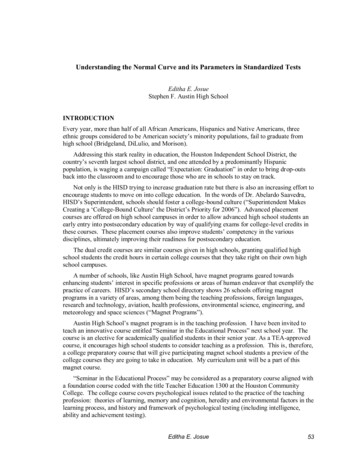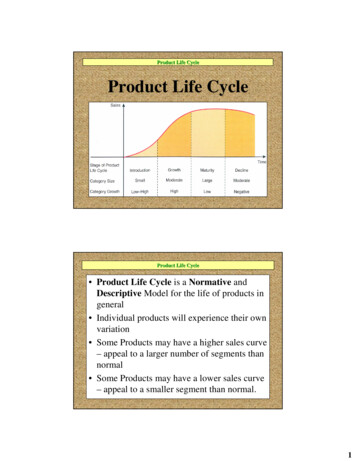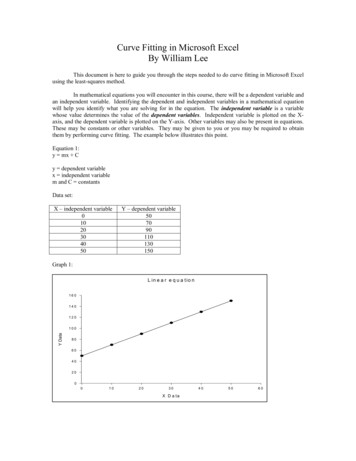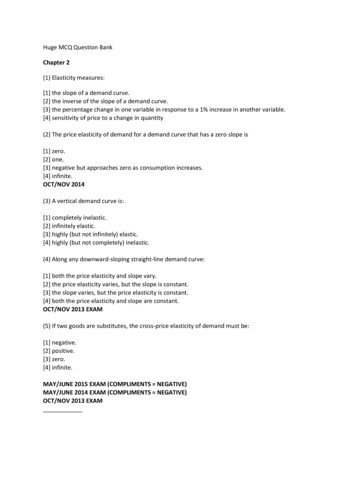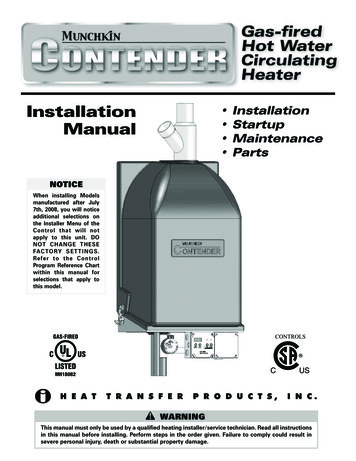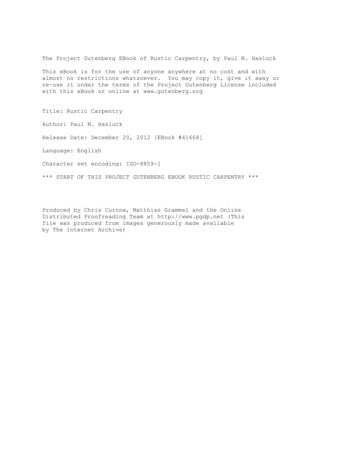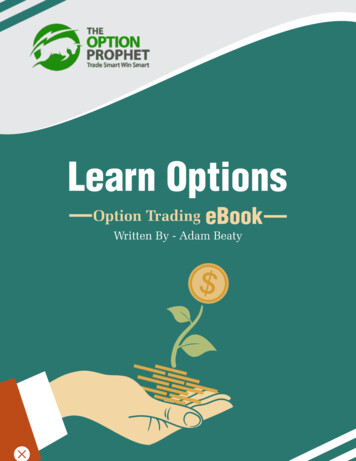
Transcription
Learn OptionsOption TradingeBookWritten By - Adam Beaty
Table of ContentsBACK TO BASICS3HISTORY OF OPTIONS3WHAT DOES AN OPTION LOOK LIKE?4COMMON OPTION DEFINITIONS57 FACTORS THAT AFFECT AN OPTION'S PRICE8OPTION STRATEGIES12LONG CALL12LONG PUT14SHORT CALL16SHORT PUT18COVERED CALL20COLLAR22BULL CALL SPREAD24BEAR PUT SPREAD26BEAR CALL SPREAD28BULL PUT SPREAD30LONG STRADDLE32SHORT STRADDLE34LONG STRANGLE36SHORT STRANGLE38LONG COMBINATION40SHORT COMBINATION42RATIO VERTICAL SPREAD WITH CALLS44RATIO VERTICAL SPREAD WITH PUTS46BACK SPREAD WITH CALLS48BACK SPREAD WITH PUTS50LONG CALENDAR SPREAD WITH CALLS52LONG CALENDAR SPREAD WITH PUTS54DIAGONAL SPREAD WITH CALLS56DIAGONAL SPREAD WITH PUTS58LONG BUTTERFLY SPREAD WITH CALLS60LONG BUTTERFLY SPREAD WITH PUTS62
Trade Smart Win SmartIRON BUTTERFLY64SKIP STRIKE BUTTERFLY WITH CALLS66SKIP STRIKE BUTTERFLY WITH PUTS68INVERSE SKIP STRIKE BUTTERFLY WITH CALLS70INVERSE SKIP STRIKE BUTTERFLY WITH PUTS72CHRISTMAS TREE BUTTERFLY WITH CALLS74CHRISTMAS TREE BUTTERFLY WITH PUTS76LONG CONDOR SPREAD WITH CALLS78LONG CONDOR SPREAD WITH PUTS80IRON CONDOR82ADVANCED TOPICS84THE GREEKS84THE GREEK CHEAT SHEET89USING OPTIONS TO PICK UP STOCK90TOP 8 MISTAKES PEOPLE MAKE TRADING OPTIONS93(SET) AND INDEX OPTION EXPIRATION99
Back to BasicsHistory of Op onsThe US op ons exchange started with the founding of the CBOE (Chicago Board Op onsExchange) in 1973. At the beginning there were a total of 16 equi es that had only callop ons. In 1977 they began to trade put op ons. There are now over 5 different exchangesac vely trading op ons.In 1975 the SEC (Securi es and Exchange Commission) approved the OCC (Op ons ClearingCorpora on) with the sole purpose of clearing all US based op ons. A clearing firm’s job is tofacilitate execu on by transferring funds, assigning deliveries, and guaranteeing the contracts.Op ons were a hit when they first appeared. In 1975 18 million contracts traded. By 1978 thatnumber had more than tripled to 60 million contracts. The increase in contracts con nued toclimb un l the 1987 stock market crash. A er the stock market crash investors were s lluneasy. In 1991 only 2/3 of the peak level contracts were traded. In 1983 we saw the firstop ons traded on an index, the S&P 500. This was a big development since it was from thisthat led to the forma on of the VIX. The VIX is the vola lity index, fear index, based on theprices of S&P 500 op ons.Enthusiasm for the op ons market didn’t return un l the 1990s. During these mes we sawthe introduc on of LEAPS (Long-term An cipa on Securi es) which allowed investors to buyop ons that expired over a year. We also saw the forma on of the OIC (Op ons IndustryCouncil) which is a non-profit organiza on developed to educate people on the risk andbenefits of op ons.
Trade Smart Win SmartWhat Does An Op on Look Like?An op on gives the buyer the right to buy or sell the underlying at a specified price andme. At the same me, the seller has the obliga on to take the opposite side and fulfill theop on upon exercise. That means that the buyer can choose if they want to exercise theop on, but the seller has to live up to the contract if the buyer does exercise.A typical op on:Let’s analyze:XYZ is the underlying instrument. This can range from equi es (companies), indexes, futures,and currency. In this case we are using the company XYZ.January is the expira on month and sets the life of the op on. Expira ons are always given interms of a month. It is understood that op ons expire on the third Friday of every month. Inthis example, a er the third Friday in January this op on will no longer exist.170 is our strike price. The strike price sets the price of the underlying if it were exercised. Thisis not the price you would pay to buy the op on.Call specifies if this is a call or put. A call is the right to buy or call the stock away from someoneelse. Too long a call you are making a bet the underlying will appreciate in price.A put is the right to sell or put the stock to someone else. Too long a put you are predic ngdeprecia on in price.A put and call can be traded long and short or also in combina on with other puts/calls tocreate spreads (more informa on on combina ons to follow).
Back to BasicsCommon Op on Defini onsIn-the-Money (ITM): For a call op on this means that the underlying is trading above the strikeprice. For example ABC is trading at 30 and the call op on has a strike price of 25. This callop on is ITM. For a put op on this means the underlying is trading below the strike price. Forexample ABC is trading at 45 and the put op on has a strike of 50. This put op on is ITM.At-the-Money (ATM): This indicates the underlying price is around the strike price. Forexample ABC is trading at 50 and the op on strike is 50. This goes for both puts and calls. Ifyou cannot tell which strike is closer than look for the strike with a delta closer to .50.Out-of-the-Money (OTM): For a call op on this means the underlying is trading below thestrike price. For example ABC is trading at 15 with the call op on strike at 20. This call op on isOTM. For a put op on this means the underlying is trading above the strike price. For exampleABC is trading at 75 and the put op on has a strike of 70. This put op on is OTM.Intrinsic Value: The amount the op on is in-the-money. Only In-the-Money (ITM) op ons carryintrinsic value.Time Value: Sets the value of me ll expira on. An op on that is Out-of-the-Money (OTM)only has me value. If an op on is In-the-Money (ITM) it is made up of both Intrinsic Value andTime Value.Exercise: To exercise an op on contract means you are fulfilling the contract and closing itout. If you exercise a call op on you are buying the shares at the strike price. If you exercise aput you are selling the shares at the strike price.
Trade Smart Win SmartAssignment: An op on assignment is the other side of the op on being exercised. In this caseyou are not the buyer of the op on instead you are the seller or writer of the op on. When abuyer exercises an op on the writer gets assigned. If you are a writer of a call op on that getsexercised then you have to give the buyer your shares. If you are a writer of a put op onthen you will receive the shares when assigned.Op on Chain: An op on chain displays all the necessary informa on for the underlyingasset. The op ons are listed by the expira on month and then broken down by all the strikesavailable. Usually Calls are listed on the le side and Puts listed on the right side. Op onChains can provide a wide variety of informa on from something basic such as the bid/ask tomore specific informa on such as the op on Greeks.
Back to BasicsExample of an op on chain:
Trade Smart Win Smart7 Factors That Affect An Op on's Price1. Stock PriceIf a call op on allows you to buy a stock at a certain price in the future than the higher that pricegoes the more the op on will be worth.Which op on would have a higher value:A call op on allows you to buy The Op on Prophet (sym: TOP) for 100 while it is trading at 80 ORA call op on allows you to buy TOP for 100 while it is trading at 120Obviously no one is going to pay 100 for something they can buy on the open market for 80, soour op on in Choice 1 will have a low value.What is more appealing is Choice 2, an op on to buy TOP for 100 when its value is 120. In thissitua on our op on value will be higher.2. Strike PriceStrike price follows along the same lines as stock price. When we classify strikes we do it as in-themoney, at-the-money or out-of-the-money. When a call op on is in-the-money it means the stockprice is greater than the strike price. When a call is out-of-the-money the stock price is less than thestrike price.A TOP call has a strike of 50 while TOP is currently trading at 60, this op on is in-the-money.On the flip side of that coin a put op on is in-the-money when the stock price is less than the strikeprice. A put op on is out-of-the-money when the stock price is greater than the strike price.A TOP put has a strike of 20 while TOP is currently trading at 40, this op on is out-of-the-money.Op ons that are in-the-money have a higher value compared to op ons that are out-of-the-money.
Back to Basics3. Type Of Op onThis is probably the easiest factor to understand. An op on is either a put or a call and the value ofthe op on will change accordingly.A call op on gives the holder the right to buy the underlying at a specified price within a specificme period.A put op on gives the holder the right to sell the underlying at a specified price within a specificme period.If you are long a call or short a put your op on value increases as the market moves higher. If youare long a put or short a call your op on value increases as the market moves lower.4. Time To Expira onOp ons have a limited life span thus their value is affected by the passing of me. As the me toexpira on increases the value of the op on increases. As the me to expira on gets closer thevalue of the op on begins to decrease. The value begins to rapidly decrease within the last thirtydays of an op on's life. The more me an op on has ll expira on, the more me the op on has tomove around.5. Interest RatesInterest rates have a very small effect on an op on's value. When interest rates rise a call op on'svalue will also rise and a put op on's value will fall.To drive this concept home let's look at the decision making process of trying to invest in TOP whileit is trading at 50.We can buy 100 shares of the stock outright which would cost us 5,000.Instead of buying the stock outright we can long an at the money call for 5.00. Our total cost herewould be 500. Our ini al outlay of cash would be smaller and this would leave us 4,500 le over.Plus, we will have the same reward poten al for half the risk. Now we can take that le over cashand invest it elsewhere such as Treasury Bills. This would generate a guaranteed return on top ofour investment in TOP.
Trade Smart Win SmartThe higher the interest rate the more a rac ve the second op on becomes. Thus, when interestrates go up calls are a be er investment so their price also increases.On the flip side of that coin if we look at a long put versus a long call we can see a disadvantage. Wehave two op ons when we want to play an underlying to the downside.You can short 100 shares of the stock which would generate cash into the brokerage and allow us toearn interest on that cash.You long a put which will cost you less money overall but not put extra cash into your brokerage thatgenerates interest income.The higher the interest rate the more a rac ve the first op on becomes. Thus, when interest ratesrise the value of put op ons drops.6. DividendsOp ons do not receive dividends so their value fluctuates when dividends are released. When acompany releases dividends they have an ex-dividend date. If you own the stock on that date youwill be awarded the dividend. Also on this date the value of the stock will decrease by the amount ofdividend. As dividends increase a put op on's value also increases and a calls' value decreases.7. Vola lityVola lity is the only es mated factor in this model. The vola lity that is used is forward vola lity.Forward vola lity is the measure of implied vola lity over a period in the future.Implied vola lity shows the "implied" movement in a stock's future vola lity. Basically it tells youhow traders think the stock will move. Implied vola lity is always expressed as a percentage, nondirec onal and on an annual basis.
The higher the implied vola lity the more people think the stock's price will move. Stocks listed on theDow Jones are value stocks so a lot of movement is not expected, thus, they have a lower impliedvola lity.Growth stocks or small caps found on the Russell 2000, conversely, are expected to move around a lot sothey carry a higher implied vola lity.
Option StategiesTrade Smart Win SmartName: Long CallDescrip on: The long call gives the buyer the right to buy the underlying at the strikeprice. The long call is used to simulate buying the underlying since you try to profit from theunderlying going up in price. Unlike buying the underlying outright the long call gives you a capfor losses since you can only lose the price of the call. Be careful though, it is easy tooverleverage yourself using calls.Setup: Buy (long) a callBias: BullishBreak-Even: Strike A Price paid for callMax Profit: Unlimited: Looking for the underlying to go as high as the sky
Option StategiesMax Loss: Limited: Price paid for the callMargin: No margin needed since call is bought outrightTime Decay: As me passes the call will drop in value. To offset rapid me decay typically call op ons arepurchased 60-150 days from expira on.Implied Vola lity: Over the life of the op on you want implied vola lity to increase, thus increasing theprice of your op on. A decrease in implied vola lity will lower the price of your op on.Notes: Purchasing calls deep out-of-the-money because they are cheap will typically result in losses.
Trade Smart Win SmartName: Long PutDescrip on: The long put gives the buyer the right to sell the underlying at the strike price. This is theequivalent to selling a stock short. The buyer of the long put will profit if the underlying drops in price.Unlike selling stock short, which can have unlimited losses, a long put has a cap on the losses since youcan only lose the price of the put.Setup: Buy (long) a putBias: Bearish Break-Even: Strike A - Price paid for putMax Profit: Limited: Underlying cannot fall below 0.00Max Loss: Limited: Price paid for the putMargin: No margin needed since put is bought outright
Option StategiesTime Decay: As me passes the put will drop in value. To offset rapid me decay typically put op ons arepurchased 60-150 days from expira on.Implied Vola lity: Over the life of the op on you want implied vola lity to increase, thus increasing theprice of your op on. A decrease in implied vola lity will lower the price of your op on.Notes: Purchasing puts deep out-of-the-money because they are cheap will typically result in losses. Thepurchase of puts is also used as protec on against long stock. If you are currently long stock and want toprotect or lock in gains from future decline you can purchase a put that will cover any downwardmovement below the strike price.
Trade Smart Win SmartName: Short CallDescrip on: The short call obligates you to sell the stock at the strike price. If the underlying finishesbelow the strike price your call will expire worthless allowing you to keep the credit. This play carriesunlimited risk so cau on is advised when pu ng this play on.Setup: Sell (short) a callBias: Neutral to BearishBreak-Even: Strike A Credit received for the sale of the callMax Profit: Limited: To credit receivedMax Loss: Unlimited: If the underlying rises above your strike price - loses will occur as long as theunderlying con nues to rise
Option StategiesMargin: Short call requires no cash outlay so margin is used. Margin is calculated by taking the greaterof:25% of the underlying security value minus the out-of-the-money amount plus the premiumreceived or10% of the underlying security value plus the premium receivedTime Decay: As me passes the call will drop in value which is what you want. You want your short call tolose value so it expires worthless or allows you to buy it back (close it) for a lower price.Implied Vola lity: Over the life of the op on you want implied vola lity to decrease, thus decreasing theprice of your op on. An increase in implied vola lity will increase the price of your op on.Notes: Short calls can profit no ma er which direc on the underlying moves. Losses will only occurabove break-even. Selling deep out-of-the-money calls can return high probability plays
Trade Smart Win SmartName: Short PutDescrip on: The short put obligates you to buy the underlying at the strike price. If the underlyingfinishes above the strike price your put will expire worthless allowing you to keep the credit. This playcarries high risk so cau on is advised when pu ng this play on.Setup: Sell (short) a putBias: Neutral to BullishBreak-Even: Strike A - Credit received for the sale of the putMax Profit: Limited: To Credit receivedMax Loss: Limited: If the underlying falls below your strike price losses will occur - but are limited due tothe fact the underlying cannot fall below 0.00
Option StategiesMargin: Short put requires no cash outlay so margin is used. Margin is calculated by taking the greaterof:25% of the underlying security value minus the out-of-the-money amount plus the premiumreceived or10% of the underlying security value plus the premium receivedTime Decay: As me passes the put will drop in value which is what you want. You want your short putto lose value so it expires worthless or allows you to buy it back (close it) for a lower price.Implied Vola lity: Over the life of the op on you want implied vola lity to decrease, thus decreasingthe price of your op on. An increase in implied vola lity will increase the price of your op on.Notes: Short puts can profit no ma er which direc on the underlying moves. Losses will only occurbelow break-even. Selling deep out-of-the-money puts can return high probability plays. Short puts canalso be turned into cash-secured puts. This is setup by holding enough cash to buy the shares if theunderlying falls below the strike price. This is a good way to pick up shares at a reduced price. Forexample if the underlying is currently trading at 65 and you are willing to purchase the stock at 60then you could sell the put on the 60 strike. If the underlying falls below 60 you will be assigned theshares and now have a long stock posi on. This is more typical for picking up long-term holdings.
Trade Smart Win SmartName: Covered CallDescrip on: A covered calls means you are buying or already own shares of the underlying and you aregoing to sell a call on it. People will do this because this posi on is rela vely safe. If the underlyingincreases in price you will sell the shares and keep the premium. If the underlying drops then you willkeep the premium.Setup: Sell (short) a call and Own or Buy (long) equal amount of sharesBias: Neutral to Slightly Bullish (If the underlying sky rockets in price you will be forced to sell at thestrike price missing out on the extra gains)Break-Even: Underlying Price - Credit received for the sale of the callMax Profit: Limited: To credit received; if the underlying price goes above strike price then profitincreases to premium received sale of the underlying
Option StategiesMax Loss: Downside risk happens only if the stock price falls to lowMargin: The short call is covered by the purchase or ownership of the stock - no margin neededTime Decay: As me passes the call will drop in value which is what you want. You want your short callto lose value so it expires worthless or allows you to buy it back (close it) for a lower price.Implied Vola lity: Over the life of the op on you want implied vola lity to decrease, thus decreasing theprice of your op on. An increase in implied vola lity will increase the price of your op on.Notes: Covered Calls are typically referred to as beginner plays because the op on cannot take a loss sothe posi on is rela vely safe. Selling calls on shares already owned is a good way to increase/boost profiton long-term posi ons. Only establish covered calls if you are comfortable with ge ng assigned, if youare okay with losing the shares because they are called away. Pu ng on a covered call when you are notwilling to give up the shares will only bring headaches and future losses.
Trade Smart Win SmartName: CollarDescrip on: This strategy creates security around your underlying posi on. When you long the put youuse the short call to pay for it. With this play you have protected your downside movement and cappedyour upside poten al.Setup: Own the stock and Sell (short) a call and Buy (long) a putBias: Neutral to Slightly Bullish (If the underlying sky rockets in price you will be forced to sell at thestrike price missing out on the extra gains)Break-Even: Two breakeven points could exist:If the play is established for a net credit (cash inflow) the break-even is the currentunderlying price - the credit receivedIf the play is established for a net debit (cash ou low) the break-even is the currentunderlying price the debit paid
Option StategiesMax Profit: Limited: The strike of the short call - the current underlying price the credit or - the debitpaidMax Loss: Losses will equal the current underlying price - the strike of the long put the debit paid or the credit receivedMargin: The short call is covered by the purchase or ownership of the stock - no margin neededTime Decay: As me passes the call will drop in value and the put will also drop in value. This is aneutral effect.Implied Vola lity: Movement in implied vola lity will also be neutral.
Trade Smart Win SmartName: Bull Call Spread or Ver cal SpreadDescrip on: The bull call spread has the same intent as the long call. However, instead of just buying thelong call you also short a call. This short call reduces your cost, reduces your risk, but also reduces yourprofit poten al.Setup: Buy (long) Strike A call and Sell (short) Strike B call - same expira on month for bothBias: Bullish with a target at the short strikeBreak-Even: Strike A debit paidMax Profit: Limited: Strike A - Strike B - Debit PaidMax Loss: Limited: Equal to the debit paid Margin: No margin required
Option StategiesTime Decay: A neutral effect - the passing of me hurts the long call and the passing of me helps theshort callImplied Vola lity: The effect of implied vola lity depends on where the underlying is in rela on to thestrikes. If the underlying is trading near the short call then you want implied vola lity to decrease. If theunderlying is near the long call then you want the implied vola lity to increase.
Trade Smart Win SmartName: Bear Put Spread or Ver cal SpreadDescrip on: The bear put spread has the same intent as the long put. However, instead of just buyingthe long put you also short a put. This short put reduces your cost, reduces your risk, but also reducesyour profit poten al.Setup: Buy (long) Strike A put and Sell (short) Strike B put - same expira on month for bothBias: Bearish with a target at the short strikeBreak-Even: Strike B - debit paidMax Profit: Limited: Strike A - Strike B - Debit PaidMax Loss: Limited: Debit paid
Option StategiesMargin: No margin requiredTime Decay: A neutral effect - the passing of me hurts the long put and the passing of me helps theshort putImplied Vola lity: The effect of implied vola lity depends on where the underlying is in rela on to thestrikes. If the underlying is trading near the short put then you want implied vola lity to decrease. Ifthe underlying is near the long put then you want the implied vola lity to increase.
Trade Smart Win SmartName: Bear Call Spread or Ver cal SpreadDescrip on: The bear call spread has the same intent as the short call. However, instead of just shor ngthe call you also long a call. The long call reduces your risk, but also reduces your credit received.Setup: Sell (short) Strike A call and Buy (long) Strike B call - same expira on month for bothBias: Neutral to bearish Break-Even: Strike A credit receivedMax Profit: Limited: Credit receivedMax Loss: Limited: Strike A - Strike B - Credit receivedMargin: Margin is equal to the Max Loss: Strike A - Strike B - Credit received
Option StategiesTime Decay: Time decay is a posi ve effect as you want both sides of the spread to expire worthlessImplied Vola lity: The effect of implied vola lity depends on where the underlying is in rela on to thestrikes. If the underlying is trading near the short call then you want implied vola lity to decrease. If theunderlying is near the long call then you want the implied vola lity to increase.
Trade Smart Win SmartName: Bull Put Spread or Ver cal SpreadDescrip on: The bull put spread has the same intent as the short put. However, instead of just shor ngthe put you also long a put. The long put reduces your risk, but also reduces your credit received.Setup: Buy (long) Strike A put and Sell (short) Strike B putBias: Neutral to BullishBreak-Even: Strike B - credit receivedMax Profit: Limited: Credit receivedMax Loss: Limited: Strike A - Strike B - Credit receivedMargin: Margin equal the Max Loss: Strike A - Strike B - Credit received
Option StategiesTime Decay: Time decay is a posi ve effect. You are looking for both sides of your spread to expireworthless.Implied Vola lity: The effect of implied vola lity depends on where the underlying is in rela on to thestrikes. If the underlying is trading near the short put then you want implied vola lity to decrease. If theunderlying is near the long put then you want the implied vola lity to increase.
Trade Smart Win SmartName: Long StraddleDescrip on: The long straddle gives you the opportunity to profit if the stock goes up or goes down.While this may seem like an ideal play the underlying has to move enough to cover the cost of bothop ons.Setup: Buy (long) Strike A put and Buy (long) Strike A callBias: Bullish and Bearish - expec ng a big move but unsure of direc onBreak-Even: Two break-even points:Strike A Debit paidStrike A - Debit paidMax Profit: Unlimited
Option StategiesMax Loss: Limited: Debit paidMargin: No margin requiredTime Decay: Time decay is an extreme nega ve effect since it will drop the value of both of your op onsImplied Vola lity: A er you establish the posi on you want implied vola lity to increase so the value ofyour op ons increase and to make the necessary move you originally planned forNotes: Long straddles can be hard to profit from due to the wide move the underlying needs to makebefore your posi on gets beaten down by me decay. Even if you are expec ng move such as anearnings announcement or report coming out the op ons could already be priced so high that it cannotcapture the move. Always make sure you find the price of an at-the-money (ATM) straddle to see howbig of a move the market is expec ng. You can use gamma scalping to protect and increase your gainswith long straddles
Trade Smart Win SmartName: Short StraddleDescrip on: The short straddle is a good play if you think the underlying will remain neutral or adecrease in vola lity. This play has the advantage of bringing you double the credit. However, you will beexposed to a lot of risk. Risk will be unlimited on the upside and substan al on the downside.Setup: Sell (short) Strike A put and Sell (short) Strike A callBias: NeutralBreak-Even: Two break-evens exist:Strike A - Credit receivedStrike A Credit receivedMax Profit: Limited: Credit received
Option StategiesMax Loss: UnlimitedMargin: Margin is the greater out of the Short Put or the Short Call the premium received from theother sideTime Decay: Time decay is a posi ve effect. You are looking for both sides of your spread to expireworthless.Implied Vola lity: A er the posi on has been put on you want implied vola lity to decrease thuslowering your op on prices.Notes: This posi on carries a lot of risk since you are naked two op ons in either direc on. Playingdirec on is not as important as playing the implied vola lity here. Look for the underlying to have a lotof vola lity and put the posi on on when you believe it will decrease.
Trade Smart Win SmartName: Long StrangleDescrip on: The long strangle gives you the opportunity to profit if the stock goes up or goes down. Theop ons you buy will be out of the money which reduces the cost over the long straddle. However it willsplit the strikes apart which increase your breakeven levels. The underlying has to move enough to coverthe cost of both op ons.Setup: Buy (long) Strike A put and Buy (long) Strike B callBias: Extreme Bullish and Extreme BearishBreak-Even: Two break-even points:Strike A - Debit paidStrike B Debit paid
Option StategiesMax Profit: UnlimitedMax Loss: Debit paidMargin: No margin requirementTime Decay: Time decay has an extreme nega ve effect since it will lower the value of both of yourop ons.Implied Vola lity: A er the posi on has been established you want implied vola lity to increase. Thiswill increase the value of your op ons plus help make the an cipated move.Notes: A Long Strangle posi on is a hard posi on to profit from. You will need a big move that themarket hasn't accounted for in a quick period before me decay eats the value from your op ons.
Trade Smart Win SmartName: Short StrangleDescrip on: The short strangle allows you to make a neutral bet on the underlying. By selling both a putand strike you receive a larger credit. However, there is s ll substan al risk involved because you canincur unlimited losses to the upside and substan al losses to the downsideSetup: Sell (short) Strike A put and Sell (short) Strike B callBias: NeutralBreak-Even: Two break-even points:Strike A - Credit receivedStrike B Credit receivedMax Profit: Limited: Credit receivedMax Loss: Unlimited
Option StategiesMargin: The margin requirement is the greater margin between the short put or the short call plus thecredit received Time Decay: Time decay is a posi ve effect. You are looking for both sides of your spreadto expire worthless.Implied Vola lity: A er the play has been established you want implied vola lity to decrease thuslowering the value of your op ons. This will also lower the chance of seeing a large move in eitherdirec on.Notes: Short Strangle is a good play to put on when you expect a decrease in implied vola lity. Be carefulwhen placing this play because you are exposed to unlimited risk.
Trade Smart Win SmartName: Synthe c LongDescrip on: This is called a synthe c long because the profit graph is iden cal to going long on theunderlying. The advantage of choosing this posi on over
learn options option trading ebook written by - adam beaty. table of contents back to basics history of options what does an option look like? common option definitions 7 factors that affect an option's price option strategies long call long put short call short
